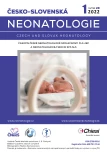Recent methods of perfusion measurement in newborn
Authors:
Straňák Zbyněk 1,2; Jacevičová Marta 1; Širc Jan 1,2; Korček Peter 1,2
Authors‘ workplace:
Ústav pro péči o matku dítě, Praha
1; 3. lékařská fakulta Univerzity Karlovy, Praha
2
Published in:
Čes-slov Neonat 2022; 28 (1): 5-11.
Category:
Reviews
Overview
Disorders of tissue perfusion are a common symptom in newborns. In clinical practice, we predominatly evaluate perfusion disorders by physical examination, blood pressure monitoring and assessment of some biochemical parameters (pH, base deficit, lactate). Recently new methods are available. These methods allow continuous monitoring of perfusion, describe quantitative and qualitative changes in perfusion, and distinguish among diferent pathophysiologies. The combination of continuous monitoring devices (near infrared spectoscopy, bioimpedance, bioreactance) with functional echocardiography and clinical examination can provide us with detailed and comprehensive information on the status of organ perfusion and optimize the therapy of hemodynamic instability. The implementation of newly branded diagnostic procedures can also reduce the severity of neonatal and post-neonatal morbidity.
Keywords:
monitoring – Cardiac output – Hypotension – Perfusion – bioimpedance – bioreactance
Sources
1. DeMers D, Wachs D. Physiology, mean arterial pressure. [Updated 2021 Apr 21]. In: StatPearls [Internet]. https://www.ncbi.nlm.nih. gov/books/NBK538226/
2. Dempsey EM, Barrington KJ, Marlow N et al. Hypotension in preterm infants (HIP) randomised trial. Arch Dis Child Fetal Neonatal 2021; 106(4): 398–403. doi: 10.1136/archdischild - 2020-320241.
3. Forman E, Breatnach CR, Ryan S et al. Noninvasive continuous cardiac output and cerebral perfusion monitoring in term infants with neonatal encephalopathy: Assessment of feasibility and reliability. Pediatr Res 2017; 82(5): 789–795. doi: 10.1038/pr.2017.154.
4. Fraga MV, Dysart KC, Rintoul N et al. Cardiac output measurement using the ultrasonic cardiac output monitor: A validation study in newborn infants. Neonatology 2019; 116(3): 260–268. doi: 10.1159/000501005.
5. McGovern M, Miletin J. Cardiac output monitoring in preterm infants. Front Pediatr 2018; 3(6): 84. doi: 10.3389/fped.2018.00084.
6. Groves AM, Chiesa G, Durighel G et al. Functional cardiac MRI in preterm and term newborns. Arch Dis Child Fetal Neonatal 2011; 96(2): F86–91. doi: 10.1136/adc.2010.189142.
7. Groves AM, Singh Y, Dempsey E et al. Introduction to neonatologist - performed echocardiography. Pediatr Res 2018; 84(Suppl 1): 1–12. doi: 10.1038/s41390-018-0076-y.
8. Gupta S, Donn SM. Assessment of neonatal perfusion. Semin Fetal Neonatal Med 2020; 25(5): 101–144. doi: 10.1016/j. siny.2020.101144.
9. Miletin J, Stranak Z, Ó Catháin N et al. Comparison of two techniques of superior vena cava flow measurement in preterm infants with birth weight less than 1250 grams in the transitional period-prospective observational cohort study. Front Pediatr 2021; 7(9): 661–698. doi: 10.3389/fped.2021.661698.
10. Miletin J, Semberova J, Martin AM et al. Low cardiac output measured by bioreactance and adverse outcome in preterm infants with birth weight less than 1250 grams. Early Hum Dev 2020; 149 : 105–153. doi: 10.1016/j.earlhumdev.2020.105153.
11. Narula J, Chauhan S, Ramakrishnan S, Gupta SK. Electrical cardiometry: A reliable solution to cardiac output estimation in children with structural heart disease. J Cardiothorac Vasc Anesth 2017 Jun; 31(3): 912–917. doi: 10.1053/j.jvca.2016.12.009.
12. Schwarz CE, Dempsey EM. Management of neonatal hypotension and shock. Semin Fetal Neonatal Med 2020; 25(5):101–121. doi: 10.1016/j.siny.2020.101121.
13. Shead SL. Pathophysiology of the cardiovascular system and neonatal hypotension. Neonatal Netw 2015; 34(1): 31–39. doi: 10.1891/0730-0832.34.1.31. PMID: 26803043.
14. Sirc J, Dempsey EM, Miletin J. Cerebral tissue oxygenation index, cardiac output and superior vena cava flow in infants with birth weight less than 1250 grams in the first 48 hours of life. Early Hum Dev 2013; 89(7): 449–452. doi: 10.1016/j.earlhumdev.2013.04.004.
15. Stranak Z, Semberova J, Barrington K et al. International survey on diagnosis and management of hypotension in extremely preterm babies. Eur J Pediatr 2014; 173(6): 793–798. doi: 10.1007/ s00431-013-2251-9.
16. Su BH, Lin HY, Huang FK et al. Circulatory management focusing on preventing intraventricular hemorrhage and pulmonary hemorrhage in preterm infants. Pediatr Neonatol 2016; 57(6): 453–462. doi: 10.1016/j.pedneo.2016.01.001.
17. Van Laere D, O‘Toole JM, Voeten M et al. Decreased variability and low values of perfusion index on day one are associated with adverse outcome in extremely preterm infants. J Pediatr 2016; 178 : 119–124.e1. doi: 10.1016/j.jpeds.2016.08.008.
Labels
Neonatology Neonatal NurseArticle was published in
Czech and Slovak Neonatology

2022 Issue 1
Most read in this issue
- Persistent pulmonary hypertension in the newborn: pathophysiology, diagnosis and treatment
- Neonatal myocardial hypertrophy
- Importance of placental transfusion on postnatal cardiopulmonary adaptation and neonatal outcome
- Treatment of neonatal hemodynamic compromise
